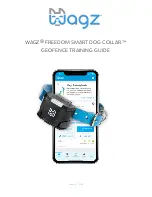
• When navigating, carefully compare information displayed on the
device to all available navigation sources, including road signs,
road closures, road conditions, traffic congestion, weather
conditions, and other factors that may affect safety while driving.
For safety, always resolve any discrepancies before continuing
navigation, and defer to posted signs and conditions.
• The device is designed to provide route suggestions. It is not a
replacement for driver attentiveness and good judgement. Do not
follow route suggestions if they suggest an illegal maneuver or
would place the vehicle in an unsafe situation.
FCC Warnings
Exposure to Radio Frequency Signals
–Your device is a radio
transmitter and receiver. When it is on, it receives and also sends
out radio frequency (RF) signals.
Antenna Care
–Use only the supplied antenna or a recommended
antenna accessory. Unauthorized antennas, modifications, or
attachments could damage the radio and may violate FCC
regulations. Warning: Do not use any radio that has a damaged
antenna, because if it comes into contact with your skin, a minor
burn can result.
Electronic Devices
–Most modern electronic equipment is shielded
from RF signals. However, certain equipment may not be shielded
against the RF signals from your wireless radio.
Pacemakers
–The Health Industry Manufacturers Association
(HIMA) and Wireless Technology Research recommend that a
minimum separation of six inches (6”) be maintained between a
handheld wireless radio and a pacemaker to avoid potential
interference with the pacemaker. Persons with pacemakers should
ALWAYS keep the radio more than six inches from their pacemaker
when the radio is turned on, should not carry the radio in a breast
pocket, and should turn the radio off immediately if you have any
reason to suspect that interference is taking place.
Hearing Aids
–Some digital wireless radios may interfere with some
hearing aids. In the event of such interference, you may want to
consult your hearing aid manufacturer to discuss alternatives.
Posted Facilities
–Turn your radio OFF in any facility where posted
notices so require.
Vehicles
–RF signals may affect improperly installed or
inadequately shielded electronic systems in motor vehicles. Check
with the manufacturer or its representative regarding your vehicle.
You should also consult the manufacturer of any equipment that
has been added to your vehicle.
Commercial Aircraft
–Many commercial airlines prohibit the use of
radios on board. Switch OFF your radio before boarding an aircraft
or check the airline rules.
Potentially Explosive Atmospheres
–Turn your radio OFF and do
not remove your battery when you are in any area with a potentially
explosive atmosphere. Obey all signs and instructions. Sparks from
your battery in such areas could cause an explosion or fire resulting
in bodily injury or even death.
NOTICE
Failure to heed the following notice could result in personal or
property damage, or negatively impact the device functionality.
Battery Notices
• Do not immerse the device or batteries in water or other liquids.
• Do not leave the device exposed to a heat source or in a high-
temperature location, such as in the sun in an unattended
vehicle. To prevent the possibility of damage, remove the device
from the vehicle or store it out of direct sunlight, such as in the
glove box.
• Do not use a power and/or data cable that is not approved or
supplied by Garmin.
• Contact your local waste disposal department to dispose of the
device/batteries in accordance with applicable local laws and
regulations.
Windshield Mounting Legal Restrictions
Before using the device on your windshield, check the state and
local laws and ordinances where you drive. Some state laws
prohibit or restrict the placement of objects on the windshield of a
motor vehicle. IT IS THE USER'S RESPONSIBILITY TO MOUNT
THE DEVICE IN COMPLIANCE WITH ALL APPLICABLE LAWS
AND ORDINANCES. Always mount your Garmin device in a
location that does not obstruct the driver's view of the road. Garmin
does not assume any responsibility for any fines, penalties, or
damages that may be incurred as a result of any state or local law
or ordinance relating to the use of your Garmin device.
GPS Dog Collar Legal Restrictions
SPECIAL NOTICE TO USERS IN CALIFORNIA AND ALASKA:
State law in California prohibits the use of GPS dog collars for the
pursuit of mammals. Alaska law prohibits guides from using GPS
devices to assist in the taking of big game animals. This is not
intended to be an exhaustive list of applicable laws and ordinances,
and Garmin makes no such guarantees or warranties that this list is
complete. Check your state and local laws and ordinances to
ensure you fully understand any restrictions applicable to this
product in your jurisdiction prior to purchase and/or use. Garmin
does not assume any responsibility for any fines, penalties, or
damages that may be incurred as a result of any state or local law
or ordinance relating to use of the product.
3














































